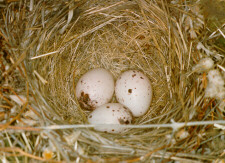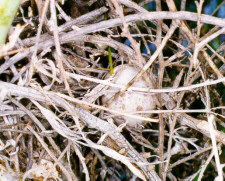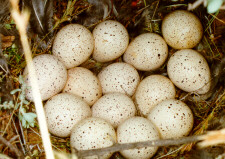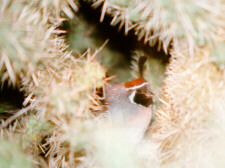More information about Curve-bill Thrasher and the continuation of the white egg with brown spots mystery.
Photos by Greg Clark, April-May 1998
 At left are Canyon Towhee eggs. Notice that the eggs are the same shape as the mystery egg, and one of the eggs has spots that are very similar in size, shape and color. However, notice that Canyon Towhee eggs have a pronounced group of spots on the big rounded end. This was not present on the mystery egg. Also, Canyon Towhees are about the same physical size as thrashers so their eggs would not be dramatically bigger.
At left are Canyon Towhee eggs. Notice that the eggs are the same shape as the mystery egg, and one of the eggs has spots that are very similar in size, shape and color. However, notice that Canyon Towhee eggs have a pronounced group of spots on the big rounded end. This was not present on the mystery egg. Also, Canyon Towhees are about the same physical size as thrashers so their eggs would not be dramatically bigger.
 Here we have one Loggerhead Shrike egg. (It has fallen out of the nest bowl and become trapped in the middle of the nest sticks). The spots are brown and the right shape, but the spots don't seem dark enough. Also, the egg seems more oval than pointed. Plus, a Loggerhead Shrike is also about the same size as a thrasher so its eggs would also not be much larger then a thrasher.
Here we have one Loggerhead Shrike egg. (It has fallen out of the nest bowl and become trapped in the middle of the nest sticks). The spots are brown and the right shape, but the spots don't seem dark enough. Also, the egg seems more oval than pointed. Plus, a Loggerhead Shrike is also about the same size as a thrasher so its eggs would also not be much larger then a thrasher.
 Here is the nest with eggs for Gambel's Quail. There are a lot of eggs here and the eggs look relatively small because the photograph is shrunk to include the whole nest in the same space as the other photos on this page. Notice that the egg on the far right side has the correct pointed shape. Also, it does have brown spots of the same color. The shape and size of the spots seems a little different, but then the spots on Gambel's Quail eggs are known to be variable. Note that some spots are darker than others as well as different in shape. This characteristic is shared with the mystery egg. You consult your favorite field guide and it says Gambel's Quail eggs are on average 31.5mm x 24mm and the same book gives the dimensions for Curve-bill eggs as 29.3 x 20.2. Not exactly dramatically different, but the eggs of the quail are bigger on average. You check the two known parasite birds in the area, Brown-headed Cowbird and Bronze Cowbird and see that there is no way it could be one of them.
Here is the nest with eggs for Gambel's Quail. There are a lot of eggs here and the eggs look relatively small because the photograph is shrunk to include the whole nest in the same space as the other photos on this page. Notice that the egg on the far right side has the correct pointed shape. Also, it does have brown spots of the same color. The shape and size of the spots seems a little different, but then the spots on Gambel's Quail eggs are known to be variable. Note that some spots are darker than others as well as different in shape. This characteristic is shared with the mystery egg. You consult your favorite field guide and it says Gambel's Quail eggs are on average 31.5mm x 24mm and the same book gives the dimensions for Curve-bill eggs as 29.3 x 20.2. Not exactly dramatically different, but the eggs of the quail are bigger on average. You check the two known parasite birds in the area, Brown-headed Cowbird and Bronze Cowbird and see that there is no way it could be one of them.
What is a Gambel's Quail egg doing in a Curve-bill Thrasher nest, built in a cholla cactus 1.75 meters above ground, when it is well known that Gambel's Quail are ground nesters and are not parasites?
We are really left with theories here, the real "answer" is probably not something that can be determined with the limited information from this one egg discovery.
1. The thrasher had already abandoned the nest and quail are known to lay eggs in abandoned thrasher nests. This known behavior doesn't seem to fit well in this case. First, the thrasher nest looked new and well maintained. It had one good egg and a shell fragment that looked like the quail egg had smashed one of the thrasher eggs when it was laid. But there were only two thrasher eggs and you would expect more. Why weren't there two good thrasher eggs?
2. The quail had lost its nest site due to predation while it was laying. Quail lay one egg a day and so this process can take two weeks before all the eggs are layed. If the process was interrupted the quail would still have eggs to lay somewhere. Perhaps there is an advantage to laying the egg somewhere besides on the ground any old place. This might provide a predator with less food so they would leave the area.
3. Both the thrasher and the quail were victims of predation. The thrasher nest was abandoned and the quail was trying to get rid of eggs anywhere safe.
4. Your theory goes here. If you have some thoughts on how this might come to pass let us know.

Gambel's Quail roosting in cholla cactus at night
Photo taken with strobe and 100mm telephoto from 10 feet away, April, 1998.
Copyright Greg Clark, 1998
update 8/2012
 At left are Canyon Towhee eggs. Notice that the eggs are the same shape as the mystery egg, and one of the eggs has spots that are very similar in size, shape and color. However, notice that Canyon Towhee eggs have a pronounced group of spots on the big rounded end. This was not present on the mystery egg. Also, Canyon Towhees are about the same physical size as thrashers so their eggs would not be dramatically bigger.
At left are Canyon Towhee eggs. Notice that the eggs are the same shape as the mystery egg, and one of the eggs has spots that are very similar in size, shape and color. However, notice that Canyon Towhee eggs have a pronounced group of spots on the big rounded end. This was not present on the mystery egg. Also, Canyon Towhees are about the same physical size as thrashers so their eggs would not be dramatically bigger. Here we have one Loggerhead Shrike egg. (It has fallen out of the nest bowl and become trapped in the middle of the nest sticks). The spots are brown and the right shape, but the spots don't seem dark enough. Also, the egg seems more oval than pointed. Plus, a Loggerhead Shrike is also about the same size as a thrasher so its eggs would also not be much larger then a thrasher.
Here we have one Loggerhead Shrike egg. (It has fallen out of the nest bowl and become trapped in the middle of the nest sticks). The spots are brown and the right shape, but the spots don't seem dark enough. Also, the egg seems more oval than pointed. Plus, a Loggerhead Shrike is also about the same size as a thrasher so its eggs would also not be much larger then a thrasher. Here is the nest with eggs for Gambel's Quail. There are a lot of eggs here and the eggs look relatively small because the photograph is shrunk to include the whole nest in the same space as the other photos on this page. Notice that the egg on the far right side has the correct pointed shape. Also, it does have brown spots of the same color. The shape and size of the spots seems a little different, but then the spots on Gambel's Quail eggs are known to be variable. Note that some spots are darker than others as well as different in shape. This characteristic is shared with the mystery egg. You consult your favorite field guide and it says Gambel's Quail eggs are on average 31.5mm x 24mm and the same book gives the dimensions for Curve-bill eggs as 29.3 x 20.2. Not exactly dramatically different, but the eggs of the quail are bigger on average. You check the two known parasite birds in the area, Brown-headed Cowbird and Bronze Cowbird and see that there is no way it could be one of them.
Here is the nest with eggs for Gambel's Quail. There are a lot of eggs here and the eggs look relatively small because the photograph is shrunk to include the whole nest in the same space as the other photos on this page. Notice that the egg on the far right side has the correct pointed shape. Also, it does have brown spots of the same color. The shape and size of the spots seems a little different, but then the spots on Gambel's Quail eggs are known to be variable. Note that some spots are darker than others as well as different in shape. This characteristic is shared with the mystery egg. You consult your favorite field guide and it says Gambel's Quail eggs are on average 31.5mm x 24mm and the same book gives the dimensions for Curve-bill eggs as 29.3 x 20.2. Not exactly dramatically different, but the eggs of the quail are bigger on average. You check the two known parasite birds in the area, Brown-headed Cowbird and Bronze Cowbird and see that there is no way it could be one of them.